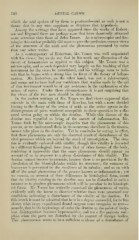Page 730 - My FlipBook
P. 730
740 DENTAL CARIES. —
which the acid spoken of by them is produced—and as such is not a
theory that in any wise supplants or displaces that hypothesis.
Among the writings that have ai)peared since the works of Robert-
son and Kegnard there are perhaps none that have deservedly attracted
more attention than those of John Tomes. As a microscopist and his-
tologist this author probably did more to give the profession correct views
of the structure of the teeth and the phenomena presented by caries
than any other writer.
As a contemporary of Robertson, Mr. Tomes was well acquainted
with his views ; but Ave do not find in his work any discussion of the
theory of fermentation as applied to this subject. Mr. Tomes was a
microscopist, and as such depended very largely on the teaching of that
instrument for the views he entertained, and his writings seem to indi-
cate that he began with a strong bias in favor of the theory of inflam-
mation. Mr, Robertson, on the other hand, was not a microscopist,
and seems not to have had any confidence that studies made by the aid
of that instrument would be of any assistance in the explanation of the
nature of caries. Under these circumstances it is not surprising that
the views of the two men should be divergent.
In the earlier writings of Mr. Tomes we find views expressed that
coincide in the main with those of Koecker, but with a more decided
loaning to the theory of the action of acids as the active agents in the
disintegration of parts rendered susceptible to their operation by a dis-
eased action going on within the dentine. While this disease of the
dentine was regarded as being of the nature of inflammation, Mr.
Tomes finds by his microscopic inquiries that the phenomena of this
process, as we understand them in its occurrence elsewhere in the tissues,
cannot take place in the dentine. Yet he concludes by saying, in eifect,
that these phenomena are only the observed result of disturbance of the
vital processes which are beyond the reach of investigation. The den-
tine is evidently endowed with vitality, though this vitality is invested
in a different histological form from that of other tissues of the body,
rendering it imjwssible that the same phenomena should appear on
account of or in response to a given disturbance of this vitality. The
dentine cannot become hypersemic, because there is no provision for the
circulation of the blood-globules within its structure ; the entrance of
leucocytes is prevented by the smallness of its tubules ; and so on with
all of the usual phenomena of the process known as inflammation yet
;
we cannot, on account of these differences in histological form, assert
that the vitality existing in the dentine may not be disturbed in such a
manner as to ])roduce phenomena which will be peculiar to its histologi-
cal forms. ]Mr. Tomes has critically examined the phenomena of caries,
evidently with the intent to discover whether there were presented any
conditions indicating a disturbance of the vitality of the dentine. In
this search it must be admitted that he is in a degree successful, for he has
shown what every cx]>ericnced dental surgeon must recognize as true
namely, that in the beginnings of caries the dentine at the point of incip-
ient disintegration becomes hypersensitive, and not a few patients com-
plain when the parts are disturbed by the contact of foreign bodies.
This phenomenon seems to be a sufficient evidence of a disturbance of


